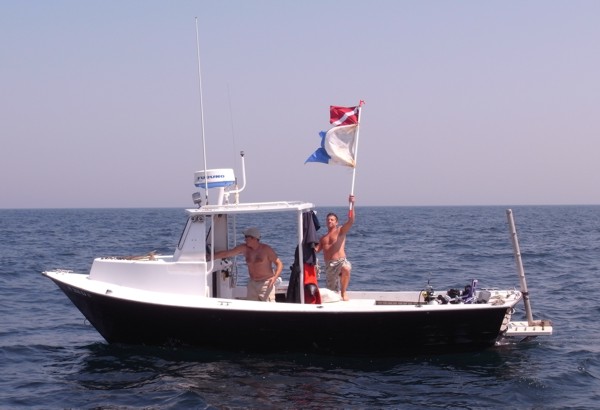During WWI the armored cruiser San Diego escorted convoys through the submarine infested waters of the North Atlantic. As irony would have it, she became the only major warship lost in the war by the US when she struck a mine in 1918. Like most warships, the giochi gonfiabili heavy guns and armor caused her to flip over when she sank. She now lies upside down in 110 ft of water a few miles off Fire Island, NY.
If you live in NJ and are interested in diving this wreck, there are a few options. First you can charter a NY boat, get up early, drive to NY, and fight NY traffic on your trip home. Captain Dan has worked out another option. He’s running charters from NJ. Due to the distance, this is more expensive than a standard charter, but can be cost effective over the tolls, gas, and traffic of the alternative.
 |
| Billy raising the flags. |
With many of the usual suspects in tow, we headed up to Fire Island. Upon arrival, we found a private dive boat tying into the bow. We agreed to tie in toward the stern. Danny had the job done in no time, and Divers started gearing up.
Before long, it was my turn. Just like it’s been down off NJ, the surface was a little snotty, then it opened up around 30 ft. Here the vis remained 30 ft or so down to the top of the wreck. Danny had us tied into the keel near one of the large holes in the hull. My general practice for new wrecks is to do an extended visual tour to get my bearings.
Given the vis, I was confident that I could see the line from either side of the wreck, so no reel was necessary. I headed into the light current, which turned out to be forward. Passing over several large breaks in the hull, I peeked in, then continued forward. Eventually the sweep of the deck became more prominent, and I found the anchor line of the other boat. They were tied into a portion of the keel that formed a loop just prior to sweeping upward. Here also were some smaller holes in the hull that allowed large Tog to swim in and out of the wreck. A large Trigger fish also darted in an out at this point, just keeping out of my reach.
I now knew we were tied in about 200 ft from the bow. It would be a long swim to the stern. I dropped down a bit along the starboard side. The vis below dropped considerably. I could not quite make out the sand, but I could make out the large guns and mounts as I passed them. Again, I peered into each large opening as I passed, pointing my light around. One opening caught my attention. I could see the light of another diver sweeping back and forth as they swam inside the wreck.
Nearing the stern, the prop shafts soon became evident. I was looking forward to seeing what would surly be an impressive set of props. No such luck. They were gone. I found out later, that they had been salvaged years ago, and the salvage effort resulted in the sinking of a savage barge. As it turns out this barge is known to be a good lobster dive.
After swimming the length of the ship, the best bet for penetration seemed to be just forward of our line. After returning to the area, I found Bill making his way in. I didn’t want to stir up the silt on him, so I went further forward where there had been some other large openings. Here the ship is not as wide, and in some of the areas, you can swim completely through. Swim in one side and out the other. Looking through the debris, on the bottom, there were coils of wire here and there, and the ever present silt. One section contained a bulkhead with what appeared to be stacks of shelves. There were openings into deeper sections of the ship, but I was running out of time, and only took the 50cent tour. After poking through a few more openings, I was about out of time, and headed back.
With the proper training and dive buddy, this wreck could be very interesting to explore. As it’s my first visit, I enjoyed just poking around in some of the more open spaces.
On the long trip home, the seas picked up a bit making for slow going, but we were still home for dinner. Had this been a charter from NY, dinner would have been much later.